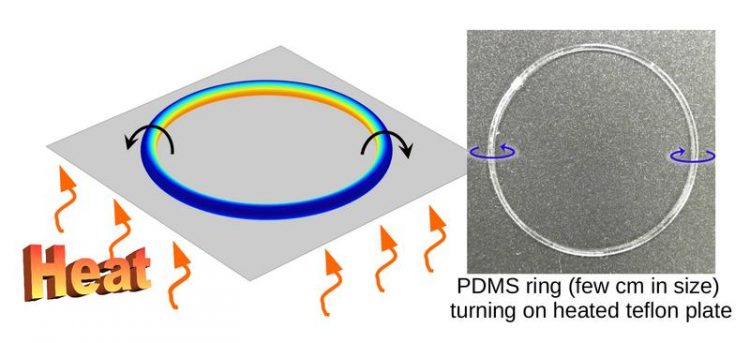Motor And Energy Store In One

With the wheel within, the researchers hit upon an extremely simple principle to set polymer materials into spontaneous motion. Picture: Falko Ziebert
Physicists and material scientists have succeeded in constructing a motor and an energy storage device from one single component. They used an elastic polymer fibre closed into a ring that was made to rotate on application of an external energy supply.
The researchers from the universities in Heidelberg and Strasbourg (France) hope that this mechanism will spur the development of intelligent materials with precisely defined functions. The findings were published in the journal “Nature Materials”.
„Our approach is minimalistic. We don’t rely on complex, high-tech materials but instead ask ourselves how the geometry and topology of a piece of material can elicit an intelligent function, such as rotation. That's how our wheel within came about,“ reports Dr Falko Ziebert of the Institute for Theoretical Physics at Heidelberg University, who co-directed the research with Dr Igor Kulić of the Institut Charles Sadron of the University of Strasbourg.
Unlike a traditional rigid wheel that travels around an axle, an elastic deformation wave forms in this wheel within, causing it to move. “Simple heat flow generates the propulsion by causing thermal expansion in the material, much like the thermal convection in our atmosphere that determines our weather and climate. This thermal deformation interacts with the prescribed deformation of the ring geometry and elicits the rotation,” explains Dr Ziebert.
With the wheel within, the researchers hit upon an extremely simple principle to set polymer materials, like a nylon thread or a rubber band, into spontaneous motion. This principle will be the basis for further research.
“Right now we are still playing with different geometries, materials, and other forms of energy flow through the system,” states Dr Kulić. One vision is to develop new technical devices with robust, self-propelled elements, in the form of artificial muscles, for instance. Researchers from the Swiss Federal Institute of Technology in Zurich (Switzerland) also contributed to the study.
Original publication:
A. Baumann, A. Sánchez-Ferrer, L. Jacomine, P. Martinoty, V. Le Houerou, F. Ziebert, Igor M. Kulić: Motorizing fibres with geometric zero-energy modes. Nature Materials (published online on 30 April 2018), doi: 10.1038/s41563-018-0062-0
Contact:
Dr Falko Ziebert
Institute for Theoretical Physics
Phone +49 6221 54-9443
ziebert@thphys.uni-heidelberg.de
Communications and Marketing
Press Office
Phone +49 6221 54-2311
presse@rektorat.uni-heidelberg.de
Media Contact
All latest news from the category: Power and Electrical Engineering
This topic covers issues related to energy generation, conversion, transportation and consumption and how the industry is addressing the challenge of energy efficiency in general.
innovations-report provides in-depth and informative reports and articles on subjects ranging from wind energy, fuel cell technology, solar energy, geothermal energy, petroleum, gas, nuclear engineering, alternative energy and energy efficiency to fusion, hydrogen and superconductor technologies.
Newest articles

Security vulnerability in browser interface
… allows computer access via graphics card. Researchers at Graz University of Technology were successful with three different side-channel attacks on graphics cards via the WebGPU browser interface. The attacks…

A closer look at mechanochemistry
Ferdi Schüth and his team at the Max Planck Institut für Kohlenforschung in Mülheim/Germany have been studying the phenomena of mechanochemistry for several years. But what actually happens at the…

Severe Vulnerabilities Discovered in Software to Protect Internet Routing
A research team from the National Research Center for Applied Cybersecurity ATHENE led by Prof. Dr. Haya Schulmann has uncovered 18 vulnerabilities in crucial software components of Resource Public Key…





















